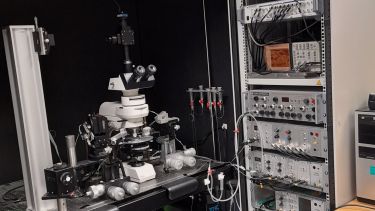Electrophysiology
Sound is detected by extremely sensitive sensory cells, called hair cells, located in the inner ear. Hair cells detect information carried by sound (e.g. pitch, loudness and timing) or motion with great precision. Sound or motion information is converted into tiny electrical impulses (a billion times smaller to that required to charge a mobile phone) that are sent to the brain via specialised auditory nerve fibres. This allows us to perceive sound such as speech and music. We study how these impulses are generated and how they are able to accurately represent sound. Click here to find out more.
How biological systems orchestrate their development and how complex signals are processed by mature neuronal networks are major challenges in the quest to understand human biology and disease. The electrophysiological groups at Sheffield use single-cell patch clamp recordings and capacitance measurements to investigate the biophysical properties of the sensory auditory and vestibular hair cells and their associated neurons to elucidate how electrical activity shapes development and drives sensory processing.
One of the rigs here at Sheffield where we conduct our electrophysiology experiments.
Example of calcium action potential activity of pre-hearing inner hair cells


